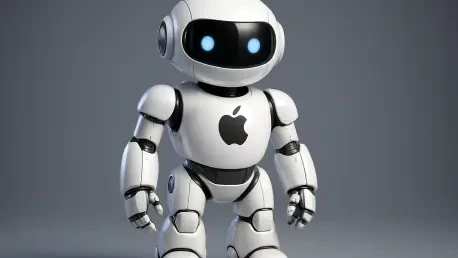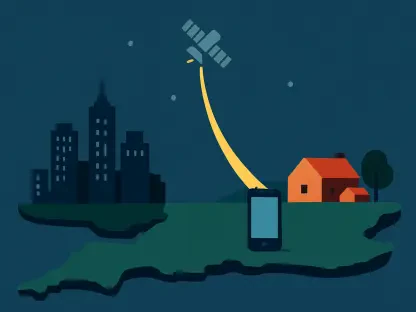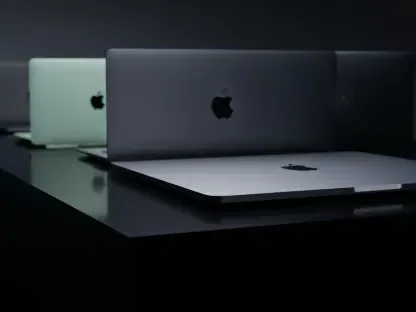In a world where technology increasingly shapes daily life, Apple Inc. has emerged with a visionary lineup of AI-driven devices and smart home solutions that could transform how people interact with their surroundings. Known for pushing boundaries, Apple is now venturing into uncharted territory with projects that include an imaginative tabletop robot, a reimagined Siri, cutting-edge smart displays, and robust home-security systems. This bold strategy, recently highlighted in a Bloomberg report, underscores Apple’s commitment to reclaiming its spot as a trailblazer in the tech industry. By weaving artificial intelligence into the fabric of personal and home environments, the company aims to stand toe-to-toe with competitors like Samsung, Google, and Amazon. This initiative isn’t just about new gadgets; it’s about crafting a seamless, intuitive experience that anticipates user needs and redefines modern living.
Crafting the Future with AI-Powered Robots
Apple’s latest innovation turns heads with a tabletop robot, internally dubbed the “Pixar Lamp” due to its striking design similarities to the iconic animated figure. Slated for a potential release around 2027, this device features a 7-inch horizontal display mounted on a motorized arm that extends up to half a foot. What sets this robot apart is its ability to physically follow users around a room, tracking movements and conversations to offer real-time assistance. Powered by an advanced, lifelike version of Siri, it engages in dynamic exchanges, remembers past interactions, and suggests personalized solutions like restaurant picks or travel itineraries. Beyond mere functionality, this robot doubles as a tool for video calls, with remote control options via an iPhone, making it a versatile companion for both personal and professional needs. This ambitious project signals Apple’s intent to blend technology with a sense of presence, creating a device that feels less like a gadget and more like a helpful ally in everyday life.
The implications of Apple’s tabletop robot extend far beyond its physical capabilities, hinting at a deeper shift in how technology integrates into personal spaces. Unlike static devices, this robot’s mobility and interactive nature aim to foster a more organic connection with users, potentially setting a new standard for personal assistants. Its design prioritizes adaptability, ensuring it can pivot and adjust to various environments, whether in a bustling home office or a quiet living room. Additionally, the integration of Siri’s enhanced features means that the robot isn’t just reactive but proactive, anticipating needs before they’re even voiced. This level of foresight could redefine expectations for AI in consumer tech, pushing competitors to innovate similarly. As Apple refines this concept over the coming years, the focus appears to be on creating not just a product but an experience—one that seamlessly bridges the gap between digital assistance and tangible interaction.
Redefining Virtual Assistance with Siri’s Evolution
At the core of Apple’s technological leap is a dramatic overhaul of Siri, codenamed “Linwood,” which promises to elevate the virtual assistant to unprecedented levels of responsiveness and personalization. Leveraging cutting-edge AI, including large language models, this updated Siri is designed to hold natural, flowing conversations while offering tailored responses to user queries. It will serve as the primary interface across Apple’s new range of devices, ensuring a consistent and intuitive experience. Features like “App Intents” enable precise voice control over applications, allowing users to navigate their digital ecosystem with ease. Whether Apple opts for its proprietary AI models or incorporates third-party solutions like Anthropic’s Claude, the goal remains clear: to transform Siri into a proactive partner that not only reacts to commands but anticipates needs with remarkable accuracy.
This transformation of Siri reflects a broader industry trend toward smarter, more empathetic virtual assistants, but Apple’s approach stands out with its emphasis on seamless integration. Unlike earlier versions that often felt limited, the revamped Siri aims to recall past interactions and build context over time, creating a sense of continuity in user engagement. This could prove invaluable in scenarios ranging from managing daily schedules to providing real-time support during complex tasks. Moreover, the assistant’s ability to adapt its responses based on individual preferences ensures a personalized touch, making interactions feel less mechanical and more human. As Apple rolls out this upgraded Siri across its product lineup, the focus on enhancing user trust and convenience could set a benchmark for competitors, potentially reshaping how virtual assistance is perceived in the tech landscape over the next few years.
Personalizing Homes with Smart Display Technology
Apple is poised to make waves in the smart home sector with the introduction of a non-robotic smart display, codenamed J490, which could hit the market as early as next year. This device promises to be a multifaceted hub, combining features like music playback, note-taking, web browsing, home control, and videoconferencing into a single, sleek unit. Running on a new operating system dubbed “Charismatic,” it merges elements of Apple TV and Apple Watch interfaces, offering customizable clock faces and widgets for a tailored look. What truly distinguishes this display is its use of facial recognition technology, which adapts content and layouts based on who is using it, making it an ideal fit for multi-user households. This focus on personalization ensures that each family member experiences a unique, relevant interface, enhancing both usability and engagement.
Beyond individual customization, Apple’s smart display aims to serve as a central point for managing daily life, integrating seamlessly with other devices in the company’s ecosystem. This connectivity allows users to control smart home features, access entertainment, and stay organized without switching between multiple platforms. The intuitive design, coupled with the “Charismatic” OS, prioritizes ease of use, ensuring that even less tech-savvy individuals can navigate its functions effortlessly. Furthermore, the emphasis on videoconferencing capabilities reflects a growing demand for tools that support remote communication, especially in a world where virtual interactions remain prevalent. As Apple positions this display to compete with similar offerings from Google and Amazon, its blend of innovation and practicality could carve out a significant share of the smart home market, redefining how families interact with technology in shared spaces.
Securing Homes with Intelligent Systems
Apple is making a determined push into the smart home security market with a battery-powered camera, codenamed J450, alongside explorations into doorbells equipped with facial recognition and infrared sensors. These devices are engineered to identify individuals at the door and trigger automated responses, such as adjusting lighting or playing specific music, enhancing both security and convenience. With integration into iCloud+ for storage, Apple is directly challenging established players like Amazon’s Ring and Google’s Nest. This move marks the company’s most significant effort to date in a sector where its HomePod speakers have struggled to gain traction. By focusing on advanced features like facial recognition, Apple aims to offer a level of sophistication that could appeal to consumers seeking comprehensive, user-friendly security solutions for their homes.
The broader vision behind Apple’s security offerings lies in creating a cohesive smart home experience that prioritizes safety without sacrificing ease of use. These devices are designed to work in tandem with other Apple products, ensuring that users can monitor and manage their home environment from a single platform. The incorporation of infrared sensors adds a layer of reliability, enabling functionality in low-light conditions, which is crucial for round-the-clock protection. Additionally, the automation capabilities mean that the system doesn’t just alert users to potential issues but actively responds to them, reducing the need for constant manual oversight. As Apple expands its presence in this competitive space, the combination of cutting-edge technology and seamless integration could position it as a formidable contender, potentially shifting consumer preferences toward a more unified approach to home security over the coming years.
Driving Innovation and Market Dominance
Under the stewardship of CEO Tim Cook, Apple is relentlessly pursuing a path to reassert its dominance as a pioneer in the tech world, with a product pipeline described as nothing short of “amazing.” This strategic mix of forward-thinking concepts, like the tabletop robot, and more immediate, practical solutions, such as smart displays and security systems, demonstrates a keen understanding of diverse consumer needs. Cook’s enthusiasm during recent internal discussions hints at confidence in both near-term releases and long-term visions. Investor optimism, reflected in notable stock gains following the Bloomberg report, further underscores the market’s faith in Apple’s ability to deliver transformative innovations. This dual focus on groundbreaking ideas and accessible technology positions the company to not only meet current demands but also shape future expectations in personal and home tech.
Apple’s comprehensive approach also highlights a nuanced strategy to maintain competitiveness across multiple fronts, balancing innovation with practicality. The tabletop robot targets a premium, futuristic segment, while smart displays and security systems address everyday concerns, ensuring broad market appeal. This versatility allows Apple to cater to a wide range of consumers, from tech enthusiasts eager for cutting-edge devices to families seeking reliable home solutions. Moreover, the company’s willingness to explore both in-house AI development and external partnerships signals a pragmatic adaptability, prioritizing effectiveness over rigid independence. As these initiatives unfold over the next few years, Apple’s commitment to seamless user experiences and interconnected ecosystems could redefine industry standards, compelling rivals to elevate their offerings in response. This dynamic push for leadership promises to keep Apple at the forefront of technological advancement.
Reflecting on a Bold Technological Leap
Looking back, Apple’s unveiling of an ambitious array of AI-driven devices and smart home solutions marked a pivotal moment in the company’s journey to redefine personal technology. The introduction of a tabletop robot, a revitalized Siri, smart displays, and advanced security systems showcased a clear intent to innovate across diverse domains. Each product, from the futuristic robot companion to the practical home camera, reflected a meticulous blend of advanced AI and user-centric design. This strategic rollout, which began capturing attention with detailed reports, demonstrated Apple’s resolve to challenge industry giants and elevate consumer experiences. As these initiatives took shape, they laid a foundation for a new era of interaction between users and their environments, driven by intelligence and seamless connectivity.
Moving forward, the focus should shift to how these innovations can be refined and scaled to meet evolving needs over the coming years. Stakeholders and consumers alike should monitor how Apple addresses potential challenges, such as privacy concerns with facial recognition or the integration of third-party AI models, to ensure trust and reliability. Exploring partnerships or open standards could further enhance device interoperability, making Apple’s ecosystem even more appealing. Additionally, attention to affordability and accessibility will be key in ensuring that these cutting-edge solutions reach a broad audience. As the tech landscape continues to evolve, Apple’s next steps should involve not only pushing technological boundaries but also fostering a dialogue around ethical AI use and sustainable design, setting a precedent for responsible innovation in an increasingly connected world.









